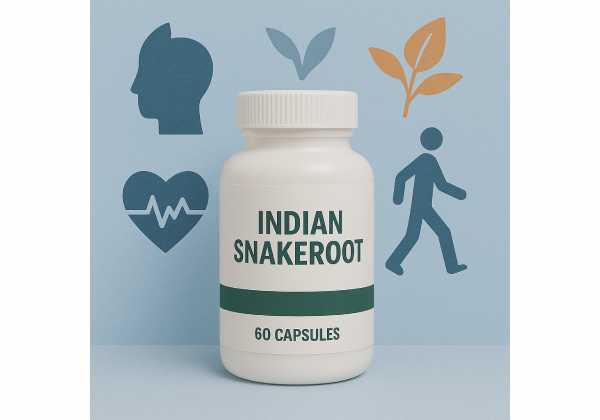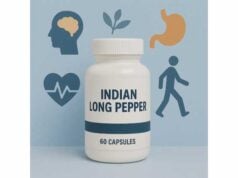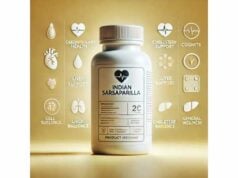
Indian snakeroot (Rauwolfia serpentina), called Sarpagandha in Ayurveda, is a classic medicinal root used for centuries across South and Southeast Asia for nervous agitation, high blood pressure, and sleep troubles. Its best-known alkaloid, reserpine, helped pioneer modern hypertension therapy. Today, whole-root preparations and standardized extracts remain in use in traditional systems, while purified reserpine is used cautiously under medical supervision in some regions. Indian snakeroot’s effects come from multiple indole alkaloids that deplete and modulate stress neurotransmitters (norepinephrine, dopamine, serotonin), which can calm the nervous system and lower blood pressure. Those same pathways also explain key risks—most notably, depression and gastrointestinal irritation—so careful dosing and screening are essential. This guide translates both tradition and modern pharmacology into practical steps: what it is, what benefits to expect, how to take it, who should avoid it, and what the research shows—so you can make informed, measured decisions.
Key Insights
- Most supported uses: reducing high blood pressure and easing nervous agitation or insomnia, especially at night.
- Typical adult ranges: 1–2 g root powder once or twice daily, or purified reserpine 0.1–0.25 mg/day only with clinician guidance.
- Main cautions: risk of depression, nasal congestion, gastric irritation or ulcer aggravation, and excessive sedation at higher doses.
- Avoid during pregnancy and lactation, and if you have a history of depression, active peptic ulcer disease, Parkinson’s disease, or are using other central nervous system depressants.
Table of Contents
- What is Indian snakeroot?
- Does it work? Key benefits
- How to use it: forms and preparations
- Dosage: how much and when
- Side effects, precautions, who should avoid
- Evidence: what studies show
What is Indian snakeroot?
Indian snakeroot is a perennial shrub native to the Indian subcontinent and surrounding regions. In Ayurveda it is named Sarpagandha, literally “snake fragrance,” referring to its aromatic roots. The medicinal part is the root and root bark, which contain a suite of indole alkaloids—most notably reserpine, ajmaline, ajmalicine (raubasine), yohimbine-like congeners, and others—that act in complementary ways on the autonomic nervous system and the cardiovascular axis.
How it works (plain-language view).
Reserpine and related alkaloids deplete stored catecholamines (norepinephrine, dopamine) from nerve endings and central stores by blocking vesicular transport. With less sympathetic “fight-or-flight” signaling, arteries relax, heart rate slows, and blood pressure falls. The quieter adrenergic tone also reduces agitation and can ease the path into sleep for some people. Because serotonin stores are also affected, mood can shift; in susceptible people, that may increase the risk of depression—a key safety consideration.
Traditional indications.
Ayurvedic texts describe Sarpagandha for unmada (agitation), anidra (insomnia), palpitations, and raktapitta-like states consistent with high blood pressure. In practice it was often combined with other botanicals to balance potency and protect the stomach.
Modern context.
By the mid-20th century, purified reserpine became a landmark antihypertensive. It is now considered second-line or niche in many places due to side-effect profiles and the availability of newer drugs. Whole-root preparations remain part of traditional practice, typically at gram-level doses under supervision, and are sometimes used as night-time calming agents in low amounts.
Quality and sustainability.
Overharvesting historically pressured wild stands. Prefer cultivated sources and suppliers that document identity, alkaloid content, and contaminant testing (heavy metals, microbial load). Good-quality root is firm, brown to gray-brown, and aromatic, without mustiness.
What it is not.
Indian snakeroot is different from American snakeroots (various genera) and from sarpgandha-named non-Rauwolfia products. Always verify the Latin binomial Rauwolfia serpentina on labels to avoid mix-ups.
Does it work? Key benefits
1) Lowering high blood pressure (hypertension).
Indian snakeroot’s strongest, most historically validated effect is blood pressure reduction. In clinical use with purified reserpine, many patients achieve meaningful systolic and diastolic drops within weeks. The effect is dose-dependent, builds gradually, and persists while therapy continues. Whole-root preparations can also lower blood pressure, though alkaloid content varies and should be standardized for clinical use. Because the mechanism is central and peripheral sympathetic dampening, Indian snakeroot may pair with thiazides or vasodilators when supervised, often at lower doses than monotherapy.
2) Calming agitation and easing insomnia.
By quieting adrenergic arousal, Indian snakeroot can reduce restlessness, muscle tension, and sleep-onset difficulty, particularly when stress-driven. Benefits are typically subtle, not sedative “knock-outs.” People often notice fewer racing thoughts at bedtime and fewer awakenings. If sedation is pronounced, the dose is likely too high (or too late in the evening).
3) Supporting heart rate control in hyperadrenergic states.
The same catecholamine-depleting action that lowers blood pressure also reduces tachycardia in states of chronic sympathetic overdrive. This is not a first-line use today, but it explains some traditional applications (palpitations, tremulousness).
4) Potential metabolic and neurobehavioral effects (contextual).
By lowering chronic sympathetic tone and improving sleep, some users experience better daytime calm and modest improvements in stress-related eating. Conversely, the same mechanism can contribute to low energy or low mood if dosing is excessive or the person is vulnerable—another reason to start low and monitor.
What to expect and when.
- Blood pressure: measurable changes often appear within 1–2 weeks, with full effect by 4–6 weeks.
- Sleep and agitation: night-to-night calming may show up in the first week, stabilizing over 2–3 weeks of consistent timing.
Who benefits most.
Adults with stage-1 to early stage-2 hypertension and a clear hyperadrenergic pattern (stress, elevated resting pulse), who either cannot tolerate first-line drugs or need a small add-on under supervision. Those with bedtime hyperarousal may benefit from tiny evening doses of whole root as part of a broader sleep program.
Key limitations.
- Side effects narrow its modern role.
- Mood risks require careful screening.
- Whole-root potency varies by harvest, storage, and extraction; choose standardized products and consistent routines.
How to use it: forms and preparations
Whole-root options (traditional).
- Powder (churna): Finely milled root. Commonly mixed with warm water or milk. Traditional adult range is 1–2 g per dose. Night-time use is most common; daytime dosing increases risks of sleepiness and nasal congestion.
- Decoction (concentrated tea): Root pieces gently simmered in water, then strained. Practical serving volumes vary (for example, 30–60 ml of a concentrated decoction in the evening).
- Standardized extracts (capsules/tablets): Labeled for total alkaloids or reserpine content. These offer consistent potency and easier titration. Seek third-party testing and clear marker ranges.
Purified alkaloid (modern drug therapy).
- Reserpine is a prescription medicine in many countries. Typical maintenance is 0.1–0.25 mg/day, sometimes combined with a thiazide. Due to side-effect profiles, this route is medical-only; do not self-dose purified reserpine.
Quality and sourcing checklist.
- Confirm Rauwolfia serpentina on the label (avoid generics like “snakeroot”).
- Prefer cultivated material; ask suppliers about sustainability.
- Look for identity testing (botanical microscopy and chromatography) and contaminant panels.
- For extracts, favor standardized total alkaloids with batch certificates.
How to integrate into an evening routine (example).
- Wind-down starts (T−60 min): Dim lights, park screens, set a consistent bedtime.
- Dose (T−45 to −30 min): 500 mg–1 g root powder or a low-end standardized extract serving with water.
- Calming ritual: Five minutes of diaphragmatic breathing or a short stretch.
- Sleep environment: Cool, dark, quiet or steady white noise.
- Lights out.
Evaluate changes in sleep latency, night awakenings, and morning energy after 2 weeks, adjusting timing or dose conservatively.
Stacking and combinations (use judgment).
- With thiazides for hypertension: possible under clinician oversight.
- With non-sedating sleep supports (magnesium glycinate, glycine): often reasonable at low doses.
- Avoid combining with other sedatives, alcohol near bedtime, or strong serotonergic agents without medical advice.
Travel or shift work.
Anchor evening dosing to the target bedtime of your destination schedule. Reduce or skip if you must remain alert (driving late, night shifts).
Dosage: how much and when
Whole-root (adult, traditional ranges).
- Powder: 1–2 g once nightly for sleep or agitation; some traditions use up to 2 g twice daily for blood pressure under supervision.
- Decoction: A concentrated preparation taken in small evening portions (for example, 30–60 ml); potency depends on starting material and simmer time.
- Standardized extract: Follow label ranges that equate to ~1–2 g root per serving, or are standardized to a low-mg total-alkaloid content. Begin at the lowest suggested serving.
Purified reserpine (medical use only).
- Initiation: often 0.5 mg/day for one to two weeks in historical protocols, now more conservatively started lower.
- Maintenance: 0.1–0.25 mg/day. Dosing beyond this raises side-effect risks without proportionate benefit for many patients.
- Tapering: If discontinuing, doctors taper to avoid rebound hypertension and autonomic symptoms.
Timing by goal.
- Hypertension: Morning or daytime dosing may be used medically; for whole-root approaches, many favor evening to minimize daytime sedation.
- Insomnia and agitation: 30–60 minutes before bedtime is typical; if you feel groggy in the morning, move the dose earlier or reduce it.
Four-week titration (whole root, example).
- Week 1: 500 mg nightly. Assess alertness next morning.
- Week 2: 1 g nightly if tolerated.
- Week 3: 1.5–2 g nightly if needed for effect; hold if sedation or nasal stuffiness appears.
- Week 4: Maintain the lowest effective dose for two additional weeks, then reassess. If no benefit by the end of week 3 at a tolerated dose, it may not be a good fit.
Upper practical limits.
- Exceeding 2 g per dose (whole root) increases odds of excessive sedation, nasal congestion, GI irritation, and mood changes.
- Never attempt to approximate purified reserpine doses using raw herb math; alkaloid content varies widely.
Special populations.
- Older adults: Start low (250–500 mg whole root). Monitor for dizziness and bradycardia.
- Pregnancy/lactation: Avoid—insufficient safety data and theoretical fetal risks.
- Liver or kidney disease: Use only with clinician guidance.
- Pediatrics: Not recommended except under specialist care.
Medication timing and interactions.
- If you take other antihypertensives, monitor blood pressure when you add or increase Indian snakeroot; doses of existing drugs may need adjustment.
- Space away from sedating antihistamines, opioids, or benzodiazepines to avoid additive effects, and seek medical advice before combining.
Side effects, precautions, who should avoid
Common, usually dose-related:
- Nasal congestion and drowsiness (often first signs that the dose is too high).
- Gastrointestinal effects: stomach heaviness, heartburn, or worsened reflux; with sustained high use, risk of gastric irritation or ulcer aggravation.
- Bradycardia (slow pulse), dizziness, or orthostatic hypotension when standing quickly.
Less common but important:
- Mood changes including low mood, anhedonia, or depression—risk rises with higher doses, personal or family history of mood disorders, or concurrent sedatives.
- Parkinsonian features (stiffness, tremor) with higher/longer dosing, due to central dopamine depletion.
- Hyperprolactinemia-like symptoms (breast tenderness, galactorrhea) are reported with strong catecholamine/serotonin depletion; uncommon at low whole-root doses.
Drug interactions and cautions:
- CNS depressants (benzodiazepines, sedating antidepressants, opioids, alcohol near bedtime): additive sedation and coordination impairment.
- Antihypertensives: combined effects can drive blood pressure or heart rate too low—coordinate with your prescriber.
- MAO inhibitors and strong serotonergic agents: theoretical and practical concerns warrant medical oversight.
- Anesthesia: pause use 7 days before elective surgery unless your clinician advises otherwise.
Who should avoid or seek medical advice first:
- Pregnant or breastfeeding individuals.
- History of depression, suicidal ideation, or bipolar disorder.
- Active peptic ulcer disease or significant GERD.
- Parkinson’s disease or extrapyramidal disorders.
- Severe kidney or liver disease without specialist guidance.
- Occupations requiring high vigilance (pilots, heavy machinery operators): test only on off-days; avoid if any residual sedation.
When to stop and get help:
- New or worsening depression, black stools, vomiting blood, fainting, or very slow pulse (<50 bpm with symptoms) require prompt medical attention.
- If you’re on purified reserpine, never stop abruptly; work with your prescriber on a taper to avoid rebound hypertension.
Practical safety tips:
- Start low, increase slowly, and aim for the lowest effective dose.
- Take with a small snack if your stomach is sensitive.
- Keep a blood pressure log (home cuff) for the first 2–4 weeks of any change.
- Reassess monthly; if benefits aren’t clear, consider discontinuing and exploring alternatives.
Evidence: what studies show
Pharmacology and mechanisms.
Modern reviews detail Indian snakeroot’s indole alkaloid profile and confirm reserpine’s classic mechanism: vesicular monoamine transporter (VMAT) inhibition leading to reduced synaptic catecholamines. This underpins blood pressure lowering, heart-rate reduction, and calming—and also explains risks such as depression with higher exposure or vulnerable patients.
Hypertension outcomes.
Historic randomized and open-label experiences—later synthesized in reviews—showed clinically relevant blood pressure reductions with reserpine and with Rauwolfia preparations. Contemporary practice largely favors newer agents for first-line therapy, but low-dose reserpine or Rauwolfia combinations see use as add-ons in selected settings. Observational data and modern trials in certain countries continue to evaluate fixed-dose combinations (for example, reserpine with hydrochlorothiazide) for cost-effective control.
Depression risk—nuance matters.
Reserpine is historically associated with depression, yet modern systematic evidence suggests the relationship is dose-, context-, and population-dependent. In older adults treated with low doses for hypertension, some analyses report no increased depression signal compared with controls. This supports the clinical principle of using the lowest effective dose, watching for mood changes, and screening for prior depressive disorders.
Other potential effects.
Preclinical studies report antioxidant, vasorelaxant, and antiarrhythmic-adjacent activities of non-reserpine alkaloids (such as ajmaline), and experimental models explore antimicrobial or metabolic effects. These findings are hypothesis-generating rather than prescriptive for human use.
Dose guidance from pharmacopeias.
The Ayurvedic Pharmacopoeia of India lists 1–2 g of dried root as an adult dose guideline. In traditional practice, clinicians often start at the low end at night and adjust based on response and tolerability, frequently combining with buffering herbs to protect the stomach.
Bottom line from the literature.
Indian snakeroot is effective at lowering blood pressure and quieting hyperadrenergic arousal, but its side-effect profile and mood risk limit broad, unsupervised use. When used, it should be targeted, low-dose, and monitored—and ideally reserved for situations where newer first-line options are unsuitable or insufficient.
References
- THE AYURVEDIC PHARMACOPOEIA OF INDIA (2001) (Pharmacopoeia)
- Reserpine (2025) (Drug Review)
- No association between low-dose reserpine use and depression in older hypertensive patient (2019) (Observational Study)
- Medicinal Plants in the Treatment of Hypertension: A Review (2020) (Review)
- The effects of reserpine on depression: A systematic review (2022) (Systematic Review)
Disclaimer
This guide is educational and does not replace individualized medical advice, diagnosis, or treatment. Indian snakeroot and reserpine can interact with medications and may worsen certain conditions. Do not start, stop, or change any treatment without consulting a qualified healthcare professional who knows your history and current medicines. If you experience new or worsening depression, black stools, severe dizziness, or very slow pulse, seek medical care promptly.
If this article helped you, please consider sharing it on Facebook, X (formerly Twitter), or your preferred platform, and follow us for future updates. Your support helps us continue producing careful, people-first health guides.










